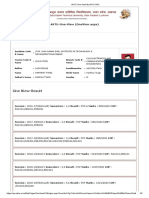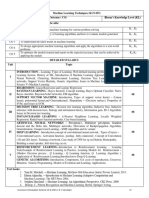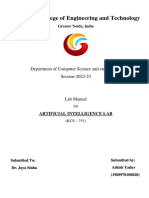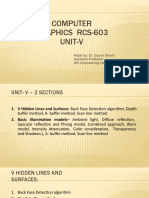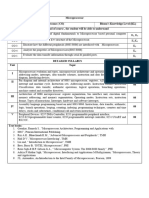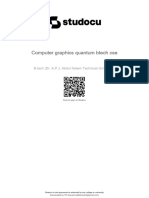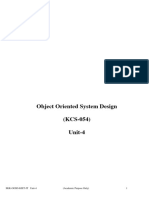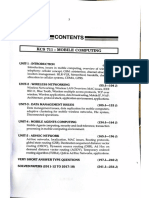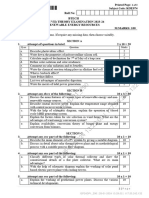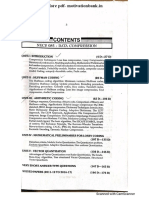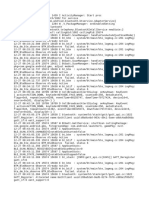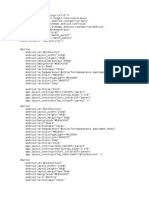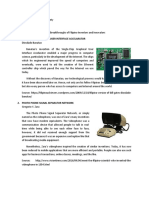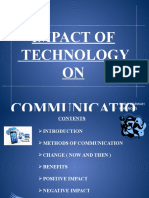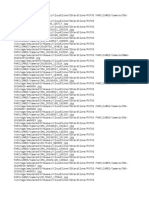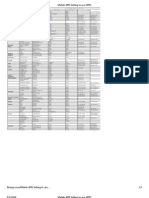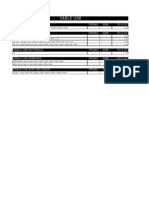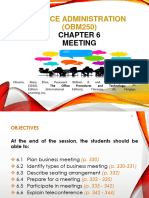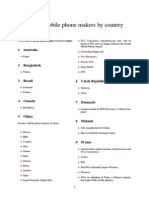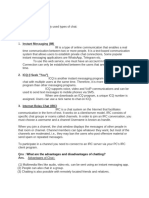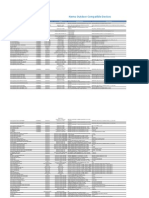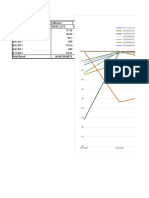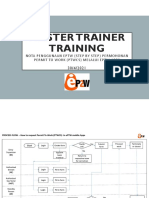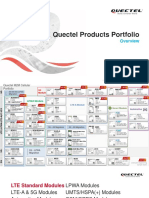0 ratings0% found this document useful (0 votes)
1K viewsAKTU Syllabus CS 3rd Yr
AKTU Syllabus CS 3rd Yr
Uploaded by
PPDC NAGAURThis document outlines the course outcomes and syllabus for a data compression course. The 5 course outcomes cover describing data compression concepts and techniques, applying static and dynamic coding techniques for text compression, evaluating predictive coding for image compression, and applying quantization techniques for image compression. The syllabus is divided into 5 units that will cover topics such as lossless vs lossy compression, information theory models, Huffman coding, dictionary techniques, predictive coding, distortion criteria, scalar and vector quantization. Students will learn foundational concepts and apply various coding and quantization methods to compress text and images.
Copyright:
© All Rights Reserved
Available Formats
Download as PDF, TXT or read online from Scribd
AKTU Syllabus CS 3rd Yr
AKTU Syllabus CS 3rd Yr
Uploaded by
PPDC NAGAUR0 ratings0% found this document useful (0 votes)
1K views1 pageThis document outlines the course outcomes and syllabus for a data compression course. The 5 course outcomes cover describing data compression concepts and techniques, applying static and dynamic coding techniques for text compression, evaluating predictive coding for image compression, and applying quantization techniques for image compression. The syllabus is divided into 5 units that will cover topics such as lossless vs lossy compression, information theory models, Huffman coding, dictionary techniques, predictive coding, distortion criteria, scalar and vector quantization. Students will learn foundational concepts and apply various coding and quantization methods to compress text and images.
Copyright
© © All Rights Reserved
Available Formats
PDF, TXT or read online from Scribd
Share this document
Did you find this document useful?
Is this content inappropriate?
This document outlines the course outcomes and syllabus for a data compression course. The 5 course outcomes cover describing data compression concepts and techniques, applying static and dynamic coding techniques for text compression, evaluating predictive coding for image compression, and applying quantization techniques for image compression. The syllabus is divided into 5 units that will cover topics such as lossless vs lossy compression, information theory models, Huffman coding, dictionary techniques, predictive coding, distortion criteria, scalar and vector quantization. Students will learn foundational concepts and apply various coding and quantization methods to compress text and images.
Copyright:
© All Rights Reserved
Available Formats
Download as PDF, TXT or read online from Scribd
Download as pdf or txt
0 ratings0% found this document useful (0 votes)
1K views1 pageAKTU Syllabus CS 3rd Yr
AKTU Syllabus CS 3rd Yr
Uploaded by
PPDC NAGAURThis document outlines the course outcomes and syllabus for a data compression course. The 5 course outcomes cover describing data compression concepts and techniques, applying static and dynamic coding techniques for text compression, evaluating predictive coding for image compression, and applying quantization techniques for image compression. The syllabus is divided into 5 units that will cover topics such as lossless vs lossy compression, information theory models, Huffman coding, dictionary techniques, predictive coding, distortion criteria, scalar and vector quantization. Students will learn foundational concepts and apply various coding and quantization methods to compress text and images.
Copyright:
© All Rights Reserved
Available Formats
Download as PDF, TXT or read online from Scribd
Download as pdf or txt
You are on page 1of 1
Data Compression (KCS-064)
Course Outcome ( CO) Bloom’s Knowledge Level (KL)
At the end of course , the student will be able to
Describe the evolution and fundamental concepts of Data Compression and Coding K1, K2
CO 1
Techniques.
Apply and compare different static coding techniques (Huffman & Arithmetic coding) for text K2, K3
CO 2
compression.
Apply and compare different dynamic coding techniques (Dictionary Technique) for text K2, K3
CO 3
compression.
CO 4 Evaluate the performance of predictive coding technique for Image Compression. K2, K3
CO 5 Apply and compare different Quantization Techniques for Image Compression. K2,K3
DETAILED SYLLABUS 3-0-0
Unit Topic Proposed
Lecture
Compression Techniques: Loss less compression, Lossy Compression, Measures of performance,
I Modeling and coding, Mathematical Preliminaries for Lossless compression: A brief introduction 08
to information theory, Models: Physical models, Probability models, Markov models, composite
source model, Coding: uniquely decodable codes, Prefix codes.
The Huffman coding algorithm: Minimum variance Huffman codes, Adaptive Huffman coding:
II Update procedure, Encoding procedure, Decoding procedure. Golomb codes, Rice codes, Tunstall 08
codes, Applications of Hoffman coding: Loss less image compression, Text compression, Audio
Compression.
Coding a sequence, Generating a binary code, Comparison of Binary and Huffman coding,
Applications: Bi-level image compression-The JBIG standard, JBIG2, Image compression.
Dictionary Techniques: Introduction, Static Dictionary: Diagram Coding, Adaptive Dictionary. The
LZ77 Approach, The LZ78 Approach, Applications: File Compression-UNIX compress, Image 08
III Compression: The Graphics Interchange Format (GIF), Compression over Modems: V.42 bits,
Predictive Coding: Prediction with Partial match (ppm): The basic algorithm, The ESCAPE
SYMBOL, length of context, The Exclusion Principle, The Burrows-Wheeler Transform: Moveto-
front coding, CALIC, JPEG-LS, Multi-resolution Approaches, Facsimile Encoding, Dynamic
Markoy Compression.
IV Distortion criteria, Models, Scalar Ouantization: The Quantization problem, Uniform Quantizer, 08
Adaptive Quantization, Non uniform Quantization.
V Advantages of Vector Quantization over Scalar Quantization, The Linde-Buzo-Gray Algorithm, 08
Tree structured Vector Quantizers. Structured VectorQuantizers.
Text books:
1. Khalid Sayood, Introduction to Data Compression, Morgan Kaufmann Publishers
2. Elements of Data Compression,Drozdek, Cengage Learning
3. Introduction to Data Compression, Second Edition, Khalid Sayood,The Morgan aufmann Series
4.Data Compression: The Complete Reference 4th Edition byDavid Salomon, Springer
5.Text Compression1st Edition by Timothy C. Bell Prentice Hall
Curriculum & Evaluation Scheme CS & CSE (V & VI semester) 29
You might also like
- Discrete Mathematics Written NotesDocument195 pagesDiscrete Mathematics Written NotesVEERESH VADDENo ratings yet
- DESIGN and ANALYSIS of ALGORITHM Hand Written NotesDocument126 pagesDESIGN and ANALYSIS of ALGORITHM Hand Written Notesशून्य अद्वैतNo ratings yet
- Computer Assisted LearningDocument15 pagesComputer Assisted Learningmanju talluri100% (4)
- AKTU Syllabus CS 3rd YrDocument2 pagesAKTU Syllabus CS 3rd YrPPDC NAGAURNo ratings yet
- AKTU One View by AKTU SDCDocument3 pagesAKTU One View by AKTU SDCKartikey TyagiNo ratings yet
- Practical - 6. To Study Single-Row Functions.: 1. Write A Query To Display The Current Date. Label The Column DateDocument4 pagesPractical - 6. To Study Single-Row Functions.: 1. Write A Query To Display The Current Date. Label The Column DateJenny PatelNo ratings yet
- PDF Programming With C Second Edition Byron GottfriedDocument2 pagesPDF Programming With C Second Edition Byron GottfriedSudhakar Bolleddu0% (6)
- Machine Learning SyllabusDocument1 pageMachine Learning Syllabuslambhaaniket8No ratings yet
- Lab Manual-ArtificialDocument26 pagesLab Manual-ArtificialYadav AshishNo ratings yet
- Idea To Business Model Koe060Document1 pageIdea To Business Model Koe060viku9267No ratings yet
- DSTL Quantum PDF by Motivation BankDocument259 pagesDSTL Quantum PDF by Motivation BankAkshay Rana100% (1)
- Sample Paper 1Document21 pagesSample Paper 1YashNo ratings yet
- Quality Management All in One Notes Unique AppSitesDocument92 pagesQuality Management All in One Notes Unique AppSitesGAURAV GUPTANo ratings yet
- AKTU Syllabus CS 3rd YrDocument4 pagesAKTU Syllabus CS 3rd YrPPDC NAGAUR75% (4)
- Ibm All 5 Unit Ibm NotesDocument29 pagesIbm All 5 Unit Ibm NotesWasim QuraishiNo ratings yet
- DSTL QuantumDocument134 pagesDSTL QuantumVipin MauryaNo ratings yet
- DaaDocument68 pagesDaaS JNo ratings yet
- Daa Lab Manual Kcs553 2022-23Document89 pagesDaa Lab Manual Kcs553 2022-232030195No ratings yet
- Computer Network UNIT 3Document28 pagesComputer Network UNIT 3Nihal GuptaNo ratings yet
- Quantum Design and Analysis of Algorithms Full PDFDocument196 pagesQuantum Design and Analysis of Algorithms Full PDFmantasha18110No ratings yet
- DSTL QuantumDocument134 pagesDSTL QuantumVipin MauryaNo ratings yet
- UNIT-5 - Hidden Lines and SurfacesDocument33 pagesUNIT-5 - Hidden Lines and SurfacesMahiye Ghosh100% (1)
- Computer Graphics Quantum-1Document246 pagesComputer Graphics Quantum-1youtenger tubeNo ratings yet
- Engineering Mathematics 1 QuantumDocument81 pagesEngineering Mathematics 1 QuantumSaurabh JaiswalNo ratings yet
- Discrete Mathematics Handwritten NotesDocument82 pagesDiscrete Mathematics Handwritten NotesBhavika PatilNo ratings yet
- Artificial-Intelligence-lab 7TH SEMESTERDocument24 pagesArtificial-Intelligence-lab 7TH SEMESTERAyush KushwahaNo ratings yet
- Air CanvasDocument31 pagesAir CanvasSourab SomasundarNo ratings yet
- Btech Oe 7 Sem Renewable Energy Resources Koe074 2022Document2 pagesBtech Oe 7 Sem Renewable Energy Resources Koe074 2022मधुसूदन सिंहNo ratings yet
- Microprocessor QuantumDocument67 pagesMicroprocessor QuantumChitransh gaur0% (1)
- Discrete Quantum Series 1-5Document134 pagesDiscrete Quantum Series 1-5Hardik AgarwalNo ratings yet
- IT8075-UNIT-5-Best-methods-of-staff-selection-Motivation SPMDocument35 pagesIT8075-UNIT-5-Best-methods-of-staff-selection-Motivation SPMCSE 2nd year 4038No ratings yet
- Computer Network QuantumDocument193 pagesComputer Network QuantumViral Videos Ka AddaNo ratings yet
- Data Compression QuantumDocument82 pagesData Compression QuantumNeetish Singh100% (1)
- Define Object Oriented Programming.: Unit I & IiDocument27 pagesDefine Object Oriented Programming.: Unit I & IiNeha AnisNo ratings yet
- AISC - Techmax (Searchable) With Index - CompressedDocument330 pagesAISC - Techmax (Searchable) With Index - Compressed16Fabian Gomes100% (1)
- Math IV Quantum (Aktu)Document147 pagesMath IV Quantum (Aktu)Mahskas RamotNo ratings yet
- 3 - JVM As An Interpreter and EmulatorDocument34 pages3 - JVM As An Interpreter and EmulatorVedika VermaNo ratings yet
- PPS Handwritten Notes Unit 3Document24 pagesPPS Handwritten Notes Unit 3Anuj ShakyaNo ratings yet
- Quantum Web Technology Kcs 602Document338 pagesQuantum Web Technology Kcs 602Khushi PachauriNo ratings yet
- Computer Graphics QuantumDocument74 pagesComputer Graphics Quantumpddwivedi45No ratings yet
- Aktu Syllabus Btech rcs403 Theory of Automata and Formal LanguagesDocument1 pageAktu Syllabus Btech rcs403 Theory of Automata and Formal LanguagesAditya KumarNo ratings yet
- Notes Unit-4 Oosd by SKKDocument32 pagesNotes Unit-4 Oosd by SKKBruce WayneNo ratings yet
- BTech. 4th Year - Computer Science and Engineering-Artificial Intelligence - Machine Learning - 2023-24 AKTU SyllabusDocument21 pagesBTech. 4th Year - Computer Science and Engineering-Artificial Intelligence - Machine Learning - 2023-24 AKTU SyllabusShubhi Tomar0% (1)
- OOSD Notes KietDocument46 pagesOOSD Notes Kietshiv.2125csit1121No ratings yet
- Career Prediction SystemDocument31 pagesCareer Prediction System067 Mohammad NoumanNo ratings yet
- Mobile Computing QuantumDocument98 pagesMobile Computing Quantumakkusingh439No ratings yet
- Java Notes CsegyanDocument21 pagesJava Notes CsegyanSudarshan GajbhareNo ratings yet
- AKTU Syllabus CS 3rd YrDocument1 pageAKTU Syllabus CS 3rd YrPPDC NAGAURNo ratings yet
- Ai Lab Manual (Kcs 751a)Document45 pagesAi Lab Manual (Kcs 751a)palak.sharma.freelanceNo ratings yet
- Assignment 2Document5 pagesAssignment 2Vasu pratap SinghNo ratings yet
- Btech Me 6 Sem Machine Design Kme602 2022Document3 pagesBtech Me 6 Sem Machine Design Kme602 2022thunderstorm8853No ratings yet
- Mis Techmax UpdatedDocument137 pagesMis Techmax UpdatedtusharNo ratings yet
- Theory of Computation Techmax PDFDocument3 pagesTheory of Computation Techmax PDFHarsh WaghelaNo ratings yet
- Operating System QuantumDocument85 pagesOperating System QuantumVarnika TomarNo ratings yet
- Project Management Entrepreneurship Quantum AktuDocument68 pagesProject Management Entrepreneurship Quantum AktuPPDC NAGAURNo ratings yet
- Koe074 Renewable Energy ResourcesDocument2 pagesKoe074 Renewable Energy Resourcessahuritik314No ratings yet
- COA Module - 1 (Handwritten Notes)Document32 pagesCOA Module - 1 (Handwritten Notes)Abcd EfghNo ratings yet
- Soft Computing QuantumDocument100 pagesSoft Computing Quantumshivansh srivastavaNo ratings yet
- Dbms Unit 4 Unit NotesDocument11 pagesDbms Unit 4 Unit NotesHimanshu KashyapNo ratings yet
- Compiler Design Handwritten NotesDocument93 pagesCompiler Design Handwritten NotesAdityaNo ratings yet
- Microsoft Word - B.tech. 4th Year IT CBCS 2019-20Document2 pagesMicrosoft Word - B.tech. 4th Year IT CBCS 2019-20Buddha Institute of Technology GIDA, GorakhpurNo ratings yet
- PDFDocument5 pagesPDFvishvaNo ratings yet
- Lotus Completeset UKG FinalDocument136 pagesLotus Completeset UKG FinalPPDC NAGAURNo ratings yet
- Curriculum of 3 D Animation and Special EffectDocument33 pagesCurriculum of 3 D Animation and Special EffectPPDC NAGAURNo ratings yet
- Public Service Commission, WBDocument2 pagesPublic Service Commission, WBPPDC NAGAURNo ratings yet
- UntitledDocument75 pagesUntitledPPDC NAGAURNo ratings yet
- Project ListDocument8 pagesProject ListPPDC NAGAURNo ratings yet
- UntitledDocument85 pagesUntitledPPDC NAGAURNo ratings yet
- UntitledDocument193 pagesUntitledPPDC NAGAURNo ratings yet
- AKTU Syllabus CS 3rd YrDocument1 pageAKTU Syllabus CS 3rd YrPPDC NAGAURNo ratings yet
- Indian Traditions, Cultural and Society: L: T:P: 2: 0:0 Module 1-Society State and Polity in IndiaDocument2 pagesIndian Traditions, Cultural and Society: L: T:P: 2: 0:0 Module 1-Society State and Polity in IndiaKapilNo ratings yet
- AKTU Syllabus CS 3rd YrDocument4 pagesAKTU Syllabus CS 3rd YrPPDC NAGAUR75% (4)
- Guidelines To The International Roaming BSNLDocument3 pagesGuidelines To The International Roaming BSNLSaurabh SenapatiNo ratings yet
- Scientific ReportDocument60 pagesScientific ReportKiya DasigNo ratings yet
- NEMO Outdoor8.20 Compatible DevicesDocument9 pagesNEMO Outdoor8.20 Compatible DevicesemilsonacruzNo ratings yet
- Mobile Viewer: User ManualDocument29 pagesMobile Viewer: User ManualRaulHerreraNo ratings yet
- Thesis On Video ConferencingDocument7 pagesThesis On Video Conferencingubkciwwff100% (2)
- Mobile Phone Market SurveyDocument50 pagesMobile Phone Market SurveyrincepNo ratings yet
- SMK Negeri 1 Oku: Format Penilaian PembelajaranDocument11 pagesSMK Negeri 1 Oku: Format Penilaian PembelajaranEny EriantiNo ratings yet
- XML Code For Surah YaseenDocument2 pagesXML Code For Surah YaseenSpread IslamNo ratings yet
- Android Advisor Latest Smartphone PDFDocument140 pagesAndroid Advisor Latest Smartphone PDFAlfa Fredrick Yosep LieputraNo ratings yet
- Science, Technology, and SocietyDocument3 pagesScience, Technology, and Societycollegestudent2000No ratings yet
- Presentation Impact of Technology On CommunicationDocument12 pagesPresentation Impact of Technology On Communicationrushi marwahNo ratings yet
- TraceDocument4 pagesTraceAayush PandeyNo ratings yet
- Pic Favorite SDDocument26 pagesPic Favorite SDJesus Farley Quintero VillotaNo ratings yet
- FT - Holly Black - Fapturile Vazduhului - Vol. 3 - Regina Fara RegatDocument321 pagesFT - Holly Black - Fapturile Vazduhului - Vol. 3 - Regina Fara RegatSimona TomaNo ratings yet
- Bharti Airtel ChapterDocument84 pagesBharti Airtel ChapterGoutham BindigaNo ratings yet
- Mobile APN Setting To Use GPRSDocument3 pagesMobile APN Setting To Use GPRSChristian BarnardNo ratings yet
- Lista Celulares 10-09-2020 - BDocument4 pagesLista Celulares 10-09-2020 - BKevin CribbNo ratings yet
- Module Purposive Comm Revised MidtermDocument26 pagesModule Purposive Comm Revised MidtermMaden beto100% (2)
- Tarif GSMBDocument66 pagesTarif GSMBadam912No ratings yet
- Chapter 6 - MeetingDocument41 pagesChapter 6 - Meeting2023164411No ratings yet
- List of Mobile Phone Makers by CountryDocument5 pagesList of Mobile Phone Makers by CountryUday EdapalapatiNo ratings yet
- 10th Class Web ServicesDocument5 pages10th Class Web Servicesmamtadevi021991No ratings yet
- Blog IphoneDocument4 pagesBlog IphoneFeras TemimiNo ratings yet
- Nemo Outdoor 7.3.0.6 Compatible Devices 9th April 2014Document6 pagesNemo Outdoor 7.3.0.6 Compatible Devices 9th April 2014امين بوعزيزNo ratings yet
- Quizizz: Introducing Oneself and OthersDocument16 pagesQuizizz: Introducing Oneself and OthersZul ZuliyahNo ratings yet
- Data PerformanceDocument196 pagesData PerformanceIbnu Abdillah MuhammadNo ratings yet
- Master Trainer User Manual (115007)Document38 pagesMaster Trainer User Manual (115007)Banzaii BlueNo ratings yet
- Quectel Products Portfolio Overview V2.6Document146 pagesQuectel Products Portfolio Overview V2.6BhaskarNo ratings yet
- Importance of Using ComputerDocument22 pagesImportance of Using ComputerAisyah RadhiahNo ratings yet




